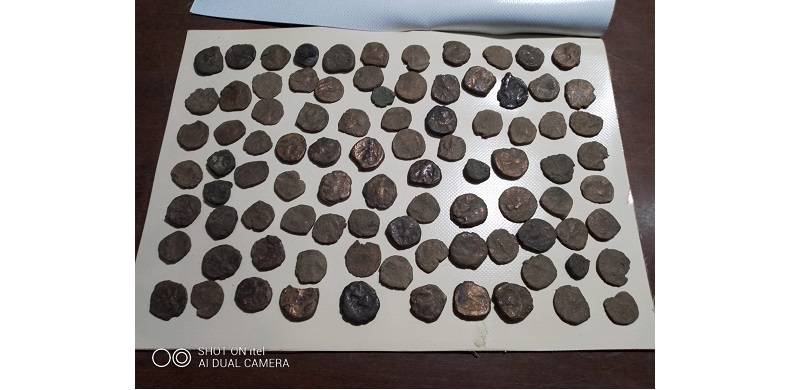
After visiting Bombay, Poona and Ahmedabad, Assistant Superintendent in the Archaeological Survey of India DR Bhandarkar came to visit Khudabad in Sindh on 25 February 1912. He inspected some buildings at Khudabad and left for Sukkur. Later he went to Hyderabad and inspected Dhar, Mandu and Indore. Bhandarkar again journeyed to Sindh and arrived at Thatta on 21 March 1912. He did an inspection of the buildings at the Makli Hills and Thatta. On 25 March 1912 Bhandarkar left Thatta for Dokri in District Larkana. During this tour, he inspected the old site of Mohenjodaro on 26 March 1912. He described Mohenjodaro in the Progress Report of the Archaeological Survey of India, Western Circle for the year ending 31 March 1912.
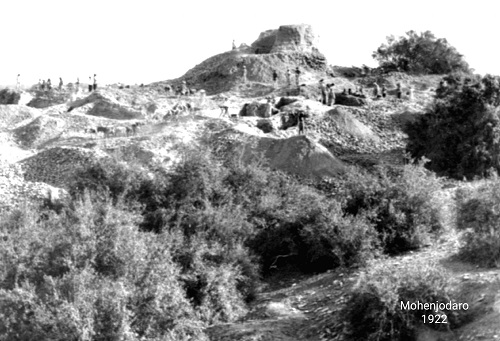
The first excavations at Mohenjodaro
RD Banerji visited the ruins of Vinjnot on 20 December 1919. From December 1919 to December 1922, surveying between the present channel of the River Indus and the Khirthar Range, Banerji came across no fewer than 18 old beds of the River Indus. Banerji conducted this survey in the western parts of the Shahdadkot, Kamber, Ghaibidero, Kakar, Johi and Sehwan areas of Larkana District. Mostly these were backward and remote areas at that time.
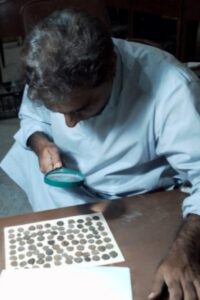 Banerji decided to excavate at Mohenjodaro at the end of the working season of 1921-22. On his request, Sir J. L Rieu, the ICS, Commissioner of Sindh was pleased to transfer the entire area (750 acres), then known to be covered with ruins, to the Archaeological Department. The area was handed over to him by an Assistant of the Deputy Conservator of Forest in Sindh. A plan showing the general contour of the ruins was also prepared. At the time of the survey, Banerji came to the conclusion that the ancient city was built on the southern bank of one of the oldest beds of the River Indus. He excavated the Buddhist Stupa and Monastery at first on the banks of Lanyaro Lake.
Banerji decided to excavate at Mohenjodaro at the end of the working season of 1921-22. On his request, Sir J. L Rieu, the ICS, Commissioner of Sindh was pleased to transfer the entire area (750 acres), then known to be covered with ruins, to the Archaeological Department. The area was handed over to him by an Assistant of the Deputy Conservator of Forest in Sindh. A plan showing the general contour of the ruins was also prepared. At the time of the survey, Banerji came to the conclusion that the ancient city was built on the southern bank of one of the oldest beds of the River Indus. He excavated the Buddhist Stupa and Monastery at first on the banks of Lanyaro Lake.
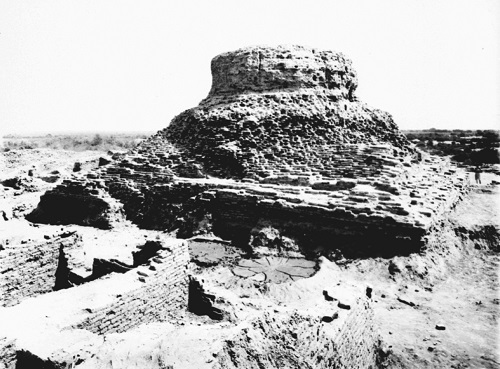
Coins discovered by RD Banerji
In 1922, Banerji found Chalcolithic (3rd millennium BC) remains at Mohenjodaro, beneath a Buddhist Stupa. This shrine was built by Kushan kings after the decline of Indus Valley Civilisation in 150 AD. The Buddhist Stupa and monastery were abandoned in 500 AD.
He conducted excavations at three sites and discovered the Indus Valley Civilisation (2600-1900 BC) for the first time. He found pottery, seals, stone, faience and bone objects, metal objects and copper coins from the remains of Mohenjodaro. These copper coins were found by Banerji in 1922-23 from the chambers situated around the stupa.
The earliest archaeological evidence of Indian coinage dates back to the fourth century BC. These were the punch-marked coins which have been found from Benares, Punjab and Mathura. The use of coins spread quickly in northern India during the Mauryan Empire. In the wake of the Greek influence in northern India, various tribes, kings and cities issued their coins. The Romans traded with Indians in gold and silver coins. Later, the Kushans, the Guptas and the Huns issued coins.
NG Majumdar wrote a note on the copper coins found from the stupa area of Mohenjodaro, which was included by Sir John Marshall in his book Mohenjodaro and the Indus Valley Civilisation (1931).
According to NG Majumdar these 2,170 coins may be classified as follows:
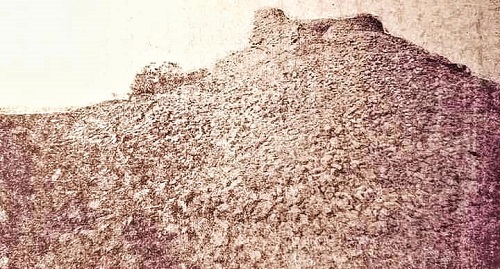
Copper coins discovered by Sir John Marshall and team
Sir John Marshall writes in his book Mohenjodaro and the Indus Valley Civilisation that, “It is noteworthy that during the excavations of 1927-28 in the stupa section we unearthed a hoard of about 1,100 copper coins, which are all of Vasudeva and do not include a single specimen of coins of class II.” Sir Henry Cousens also wrote on Mohenjodaro in his book entitled Antiquities in Sind in 1929.
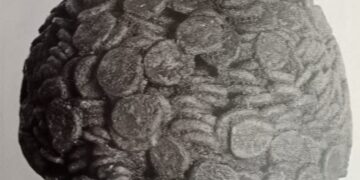
Copper coins discovered by Mackay
Ernest JH Mackay was an archaeologist from Bristol England. He carried out excavations in Egypt and surveyed ancient monuments in Palestine and Syria. He went to Mesopotamia (Iraq) and excavated at Jemdet Nasr and Kish from 1922-25. He also did archaeological excavations at Mohenjodaro from 1927 to 1931. His site report entitled Further Excavations at Mohenjodaro was published in 1938 from New Delhi India. In his above-mentioned book Mackay writes: “In the excavations of Divinity Street, we were so fortunate as to find a considerable hoard of Kushan coins […] numbered 1,078 in all, and despite being in a jar were very badly corroded. This hoard of coins was found […] beneath the floor of room of the Buddhist Monastery which partly overlay Divinity Street, that street having long since been filled up with debris and windborne dust.”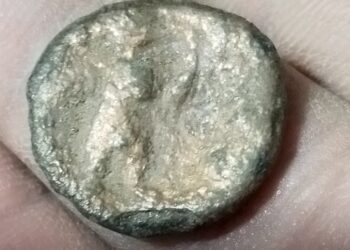
All these 4,348 coins were placed in different Indian museums – including the Mohenjodaro Archaeological Museum located in Taluka Dokri, District Larkana, Sindh. In the early 1950s, some copper coins were also found by British archaeologist Sir Mortimer Wheeler during excavations at Mohenjodaro.
But where are these coins now?
They are stored in the reserve collections and Museums of Pakistan, India and England. We should bring these artefacts to light and conduct research on this ancient coinage from different directions. The Culture, Tourism, Antiquities & Archives Department, Government of Sindh can play an important role in this context.

The first excavations at Mohenjodaro
RD Banerji visited the ruins of Vinjnot on 20 December 1919. From December 1919 to December 1922, surveying between the present channel of the River Indus and the Khirthar Range, Banerji came across no fewer than 18 old beds of the River Indus. Banerji conducted this survey in the western parts of the Shahdadkot, Kamber, Ghaibidero, Kakar, Johi and Sehwan areas of Larkana District. Mostly these were backward and remote areas at that time.
 Banerji decided to excavate at Mohenjodaro at the end of the working season of 1921-22. On his request, Sir J. L Rieu, the ICS, Commissioner of Sindh was pleased to transfer the entire area (750 acres), then known to be covered with ruins, to the Archaeological Department. The area was handed over to him by an Assistant of the Deputy Conservator of Forest in Sindh. A plan showing the general contour of the ruins was also prepared. At the time of the survey, Banerji came to the conclusion that the ancient city was built on the southern bank of one of the oldest beds of the River Indus. He excavated the Buddhist Stupa and Monastery at first on the banks of Lanyaro Lake.
Banerji decided to excavate at Mohenjodaro at the end of the working season of 1921-22. On his request, Sir J. L Rieu, the ICS, Commissioner of Sindh was pleased to transfer the entire area (750 acres), then known to be covered with ruins, to the Archaeological Department. The area was handed over to him by an Assistant of the Deputy Conservator of Forest in Sindh. A plan showing the general contour of the ruins was also prepared. At the time of the survey, Banerji came to the conclusion that the ancient city was built on the southern bank of one of the oldest beds of the River Indus. He excavated the Buddhist Stupa and Monastery at first on the banks of Lanyaro Lake.
Coins discovered by RD Banerji
In 1922, Banerji found Chalcolithic (3rd millennium BC) remains at Mohenjodaro, beneath a Buddhist Stupa. This shrine was built by Kushan kings after the decline of Indus Valley Civilisation in 150 AD. The Buddhist Stupa and monastery were abandoned in 500 AD.
He conducted excavations at three sites and discovered the Indus Valley Civilisation (2600-1900 BC) for the first time. He found pottery, seals, stone, faience and bone objects, metal objects and copper coins from the remains of Mohenjodaro. These copper coins were found by Banerji in 1922-23 from the chambers situated around the stupa.
The earliest archaeological evidence of Indian coinage dates back to the fourth century BC. These were the punch-marked coins which have been found from Benares, Punjab and Mathura. The use of coins spread quickly in northern India during the Mauryan Empire. In the wake of the Greek influence in northern India, various tribes, kings and cities issued their coins. The Romans traded with Indians in gold and silver coins. Later, the Kushans, the Guptas and the Huns issued coins.
NG Majumdar wrote a note on the copper coins found from the stupa area of Mohenjodaro, which was included by Sir John Marshall in his book Mohenjodaro and the Indus Valley Civilisation (1931).
According to NG Majumdar these 2,170 coins may be classified as follows:
- 338 coins of the Kushan king Vasudeva-I, bearing the standing royal figure on the obverse and the figure of Siva and the bull, or a throned goddess, on the reverse.
- 1,823 rectangular or oblong coins bearing a nimbate (wearing a nimbus or halo) figure, the cross, the trident, series of pellets, etc., on one side or the other but without any legends (writing)
- Nine oblong or circular pieces with the device of the fire altar on one side and a crude human figure on the other, and similarly without legends. Such coins were also found from Taxila during excavations.

Copper coins discovered by Sir John Marshall and team
Sir John Marshall writes in his book Mohenjodaro and the Indus Valley Civilisation that, “It is noteworthy that during the excavations of 1927-28 in the stupa section we unearthed a hoard of about 1,100 copper coins, which are all of Vasudeva and do not include a single specimen of coins of class II.” Sir Henry Cousens also wrote on Mohenjodaro in his book entitled Antiquities in Sind in 1929.

Copper coins discovered by Mackay
Ernest JH Mackay was an archaeologist from Bristol England. He carried out excavations in Egypt and surveyed ancient monuments in Palestine and Syria. He went to Mesopotamia (Iraq) and excavated at Jemdet Nasr and Kish from 1922-25. He also did archaeological excavations at Mohenjodaro from 1927 to 1931. His site report entitled Further Excavations at Mohenjodaro was published in 1938 from New Delhi India. In his above-mentioned book Mackay writes: “In the excavations of Divinity Street, we were so fortunate as to find a considerable hoard of Kushan coins […] numbered 1,078 in all, and despite being in a jar were very badly corroded. This hoard of coins was found […] beneath the floor of room of the Buddhist Monastery which partly overlay Divinity Street, that street having long since been filled up with debris and windborne dust.”

All these 4,348 coins were placed in different Indian museums – including the Mohenjodaro Archaeological Museum located in Taluka Dokri, District Larkana, Sindh. In the early 1950s, some copper coins were also found by British archaeologist Sir Mortimer Wheeler during excavations at Mohenjodaro.
But where are these coins now?
They are stored in the reserve collections and Museums of Pakistan, India and England. We should bring these artefacts to light and conduct research on this ancient coinage from different directions. The Culture, Tourism, Antiquities & Archives Department, Government of Sindh can play an important role in this context.

